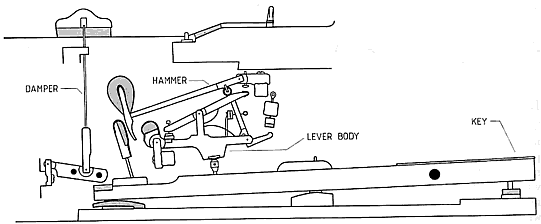

[<- Previous] [Contents of this lecture] [Next ->]
First of all, let us present a rather detailed description of the function of the grand piano action. The actions of all grand pianos of today are in principle identical, and the small differences which do remain are limited to the design of the individual parts.

|
| Fig. 1. View of the action of a modern grand piano (Steinway & Sons). The shaded areas indicate felt and the broad lines indicate leather. |
Principally, the action consists of four major parts: the key, the lever body with appurtenant parts, the hammer and the damper (see Fig. 1). The successive steps in the operation of the action during a blow is illustrated in Fig. 2.
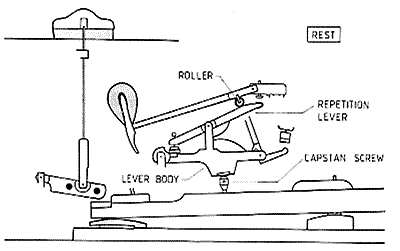 2(a) Rest position. The hammer rests via the hammer roller on the spring-supported repetition lever, a part of the lever body. The lever body stands on the key, supported by the capstan screw. The weight of the hammer and the lever body holds the playing end of the key in its upper position. The damper rests on the string, pulled down by lead weights.
2(a) Rest position. The hammer rests via the hammer roller on the spring-supported repetition lever, a part of the lever body. The lever body stands on the key, supported by the capstan screw. The weight of the hammer and the lever body holds the playing end of the key in its upper position. The damper rests on the string, pulled down by lead weights.
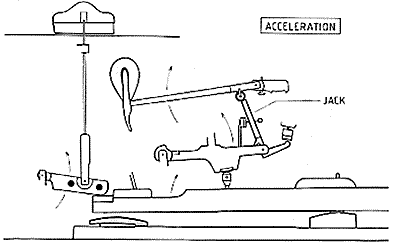 2(b) Acceleration. When the pianist depresses the key, the lever body is rotated upwards. The jack, mounted on the lever body, pushes the roller and accelerates the hammer. The damper is lifted off the string by the inner end of the key.
2(b) Acceleration. When the pianist depresses the key, the lever body is rotated upwards. The jack, mounted on the lever body, pushes the roller and accelerates the hammer. The damper is lifted off the string by the inner end of the key.
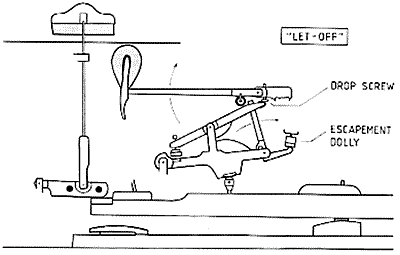 2(c) Let-off. The tail end of the jack is stopped by the escapement dolly, and the top of the jack is rotated away from the hammer roller. The hammer, which now is free, continues towards the string. The repetition lever is stopped in waiting position by the drop screw.
2(c) Let-off. The tail end of the jack is stopped by the escapement dolly, and the top of the jack is rotated away from the hammer roller. The hammer, which now is free, continues towards the string. The repetition lever is stopped in waiting position by the drop screw.
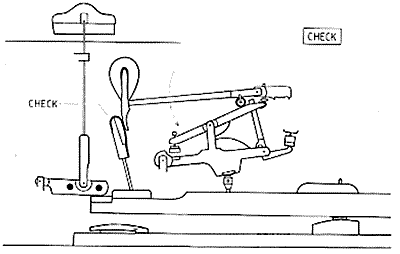 2(d) Check. The rebounding hammer falls with the hammer roller on the repetition lever, in front of the tripped jack, before it is captured at the tail of the hammer head by the check. The stroke may now be repeated, either by releasing the key as usual, or by using the double-repetition feature (see text).
2(d) Check. The rebounding hammer falls with the hammer roller on the repetition lever, in front of the tripped jack, before it is captured at the tail of the hammer head by the check. The stroke may now be repeated, either by releasing the key as usual, or by using the double-repetition feature (see text).
The action of the grand piano features a special construction for fast repetitions, the double-repetition mechanism, not incorporated in the action of the upright piano. In order to use the double-repetition feature, the key is let up only about a third of its travel after a stroke. At this stage, the hammer has been released from the check and lifted slightly by the spring-supported repetition lever (cf. Fig. 2 d). This allows the spring-loaded jack to slip back into its initial position under the roller, and the action is set for a second blow. The double-repetition mechanism enables very fast repetitions on the same key, without the damper touching the string between notes.
A correct function of the action requires a careful regulation. Of crucial importance is the distance between the top of the hammer at rest and the string, in the following hammer-string distance (piano technicians term: "blow level"). This distance is adjusted with the capstan screw (typical value 45 - 47 mm). Of equal importance is the setting of the release of the jack ("let-off"). This is adjusted with the escapement dolly. The adjustment is made by observing the distance between the string and the top of the hammer at the highest point of its travel (let-off distance), when the key is depressed slowly. The let-off distance is typically set between 1 and 3 mm, the actual value depending on such factors as the diameter of the string, interval between regulations, and sometimes, the personal taste of the pianist.
In all contact points between moving parts, one of the surfaces is covered with felt or leather in order to ensure a smooth and silent motion, free from backlash. In particular, thin shafts with close tolerances, for example the shaft for the hammer shank in the flange, are mounted in bushings of high-quality felt. The combination of wood and felt parts means that the action will change condition not only because of wear, but also due to changes in temperature and humidity. Periodic regulation is thus necessary in order to keep the instrument in optimum condition.
[<- Previous] [Top] [Contents of this lecture] [Next ->]
This lecture is one of Five lectures on the Acoustics of the piano
© 1990 Royal Swedish Academy of Music